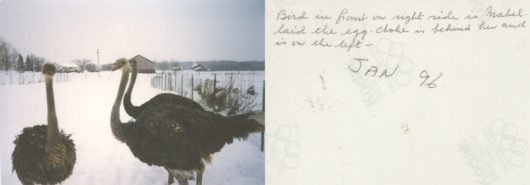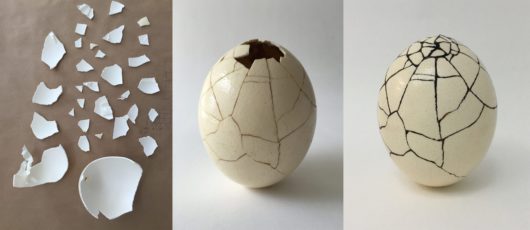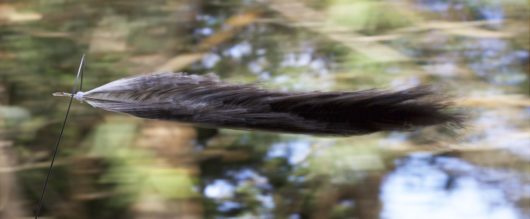Location: San Francisco, California
Many ideas grow better when transplanted into another mind than the one where they sprang up. – Oliver Wendell Holmes
I. THE BEGINNING

Front and back of photo sent with the ostrich eggs from the Stroup Farm, 1996, 4in x 6in. Photo by Lorna Stevens.
THIS ESSAY CHRONICLES OUR artistic collaboration, offering a personal account of the advantages and complexities of shared projects and exhibitions. The narrative begins with our vague desire to do something together, progresses to a series inspired by a shared material and finally results in an exhibition of work made individually but nurtured collaboratively.
We were both residents at the Vermont Studio Center in December 2014, where we developed an interest in each other’s work and in creating together. Our collaboration began without a project in mind. A search through our respective material caches netted a catalyst: three ostrich eggs sourced from Lorna’s cousin’s farm in Ohio. Inspired, but without a clear path forward, we researched the ostrich and our relationship with it. We pondered where to focus our creative endeavors and scheduled monthly meetings to check in on progress and to discuss changing thoughts, new thoughts, assumptions and doubts.
II. RESEARCH
NATIVE TO AFRICA, THE OSTRICH is not only the largest bird species; it also lays the largest egg. Though unable to fly, it can run up to 43 miles (70km) per hour, allowing it to escape formidable predators such as lions and cheetahs. It’s frenzied mating dance, which consists of alternating, rhythmic wing flaps, is guaranteed to entertain.
Humans have hunted ostriches and kept them in captivity since the Bronze Age. Mid nineteenth century millinery fashion popularized ostrich feathers, resulting in near extinction of the species. In response, ostrich farming developed, beginning in the 1900s and quickly burgeoning to over 700,000 birds in captivity. World War 1 dampened the ostrich feather industry, but interest in the ostrich’s lean meat and fashionable skins prompted a resurgence in American ostrich farming in the 1970s. The Stroup farm in Atwater, Ohio, purchased three birds including Mabel, who laid the eggs that are the foundation of this project. The Stroups soon learned that ostriches can be aggressive and possess a powerful kick potentially lethal to humans and dogs. This adversarial relationship led them to abandon ostrich farming.
Both of us were struck by human commodification of the ostrich as a resource for plumage, meat and skins. Survival of the species became a concern only when supply dipped dangerously close to extinction. Our response was to search for ways to nurture, protect, enliven and enhance the eggs.
III. DISTINCT CREATIVE APPROACHES
WE TOOK THE EGGS TO OUR studios, where Lorna made the works Repair and Protect and Joanne created When you think you’re done. Repair had an inauspicious beginning, prompted when Lorna watched in horror as one of the eggs rolled off her work table and broke into many pieces. Repair is her lacquer reconstruction of the egg following the Japanese Kintsugi technique. Kintsugi not only renders the broken vessel usable again, it embraces the imperfect by highlighting the repair seam. Developed in the 15th century, the technique involves applying successive layers of lacquer to rebuild the broken object. Each lacquer adhesion needs to cure for a few days, so piecing together the shards took almost a year to complete. To further express strength despite breakage, the egg is filled with sand to weight it to stand on end.
In Protect, Repair‘s corollary, the egg is encased in a large ball of woven steel wire. Inspired by a desire to simultaneously safeguard the egg from harm and to engage viewers with it, Lorna created a work that may be sat on or rolled around. Barely visible in its secure nest of tangled cables, the egg clinks against the wire when moved reminding us of its presence. Protect‘s construction began with Lorna’s collection of salvaged wire and progressed to larger gauge material as the piece grew in size.
As in Repair, Protect is created by repeatedly adding material until a desired outcome is achieved. The resulting two works embrace simplicity and materiality, characteristics the artist learned to appreciate when she began creating sculpture in New York during the Minimalist movement.
Joanne’s piece titled ‘When you think you’re done’ is a suspended mobile made of altered umbrellas, steel and feathers. The fabric of the umbrellas was removed revealing the aluminum skeletal spokes. The spokes are each adorned with a cut ostrich feather. A motor opens and collapses two facing umbrellas simultaneously around a central egg.

Joanne Easton, WHEN YOU THINK YOU’RE DONE, Altered umbrellas, steel, ostrich feathers and motor, 2016, 8ft x 36in x 36in. Photo by Joanne Easton.
Our diverse approaches are revealed in comparison: Repair is still and contemplative; When you think you’re done is like an iron lung.
Joanne created two additional works focused on ostrich feathers. Still Life is a painted glass vase holding three ostrich feather dusters. The vase and the handles of the dusters are painted black. Fascinated by the ubiquity of this object, its use in domestic settings and its function, she wanted to create a piece that re-contextualized the ostrich feather duster.

Joanne Easton, STILL LIFE, Ostrich feather dusters, glass vase and paint, 2016, 30in x 14in x 14in. Photo by Joanne Easton.
The second feather piece, Going 43mph, grew from our initial ostrich research. The ostrich is the largest and fastest land-bird, facts that resonated with both Lorna and Joanne. Lorna offered the theory that because the Ostrich could not fly; it could be farmed, therefore contributing to its current semi-domesticated but thriving existence. Joanne was interested in understanding the speed of the bird, reportedly reaching up to 43mph. She created a series of photographs that document an ostrich feather flying at the speed 43mph.
VI. EXHIBITION OPPORTUNITY
EARLY THIS YEAR WE WERE invited to create a ‘With the Earth’ exhibition at Gallery Route One in Point Reyes, California. After much deliberation, we titled our show Common Dilemmas, a play on the economic theory of a social shared-resource system also known as the tragedy of the commons. The concept analyzes human response to mutual and unregulated resources such as access to prime pasture land, trout filled rivers and fashionable bird feathers. We decided to use bird stories to address the complexity of sustainable practices, filtering this shared focus through our distinct creative approaches to produce diverse and complementary works. The show features the recent ostrich egg and feather pieces and extends to work from our individual practices including the Huia, the Passenger Pigeon, the Drinking Bird Toy and the Thirsty Bird Oil Derrick.
Lorna has long been interested in the adverse effects of unsustainable practices on the natural world. Her series Huia: A Story of Extinction honors this extinct New Zealand bird and chronicles its demise due to overhunting and habitat destruction. Focusing on the devastating effects of clear cutting lumber practices, where entire swaths of New Zealand bush were cleared to feed the burgeoning timber industry from 1860-1970, she created an installation of lumber, native branches, birdcall and documentation. The birdcall, the only known recorded sound of the huia, is whistled by Maori tracker Henare Hamana. The documentation, a large-scale photo of clear cutting by James Bragge, is placed under the sculpture.

Lorna Stevens, HUIA: A STORY OF EXTINCTION (DEFORESTATION), 2016, salvaged lumber, native branches, photograph (James Bragge, Bush Scene, circa 1875, reproduction from black and white collodion glass negative, Museum of New Zealand Te Papa Tongarewa), audio from the New Zealand Broadcasting Corporation’s 1954 recoding of Maori tracker Henare Hamana’s whistled huia call, 7ft x 3ft x 3ft. Photo by Lorna Stevens.
In addition, Lorna created new work in homage to the passenger pigeon. Once the most abundant bird in the world, the last passenger pigeon died in1914. Considered cheap meat, the birds were zealously hunted throughout their native North America. To tell this story, Lorna collected clay pigeon shards from the Santa Clara Field Sports Park Shooting Range and configured them into bird-like forms.

Lorna Stevens, PASSENGER PIGEONS, salvaged clay pigeons, dimensions variable. Photo by Lorna Stevens
Joanne visually comments on our insatiable need for natural resources in ‘Sisyphean Toys,’ an open-stage shadow-puppet display with a working motorized model-train Oil Derrick and a Drinking Bird toy, both continuously bobbing up and down together. The characters and the operations of the puppet show sit atop a steel oil barrel. A flashlight creates the projection and a semicircular sunset halo on the projection screen. All the pieces are visible for the viewer in this lo-fi animation setup.

Joanne Easton, SISYPHEAN TOYS (PUPPET SHOW), Motorized model oil Derrick, drinking bird toy, oil barrel and screen, 2016, 7.5ft x 3ft x 3ft. Photo by Joanne Easton.
These descriptions attribute the works to each of us individually, but all the pieces were informed by our frequent interaction. Some ideas were abandoned by one of us only to find their way into a piece by the other. Studio days were filled with photos of work in progress sent back and forth. Responses were honest and carefully considered. The process saved many a trip far afield. Like a good GPS system, we kept each other on track, aware this was our show, not an individual endeavor.
V. GROUP PROJECT
OUR EMBRACE OF COLLABORATION and diverse creative approaches is most apparent in the Ostrich Feather Wedding Dress Project. Research into our relationship with the ostrich, specifically our desire to adorn ourselves with its feathers, led us to purchase an ostrich feather wedding dress on eBay for $50. We experienced many false starts before we realized that the dress didn’t need transformation; it was itself an interesting object rife with interpretations. We decided this was where we wanted to focus. Both being teachers, we delight in our students’ varied and unique responses to the same assignment. And, since we were truly enjoying our collaboration, why not extend our shared endeavor to the artistic community? We invited artists to borrow the dress for a week and create a two-dimensional or wall hung three dimensional work inspired by it. For many months the dress travelled between various studios in the bay area, resulting in twelve diverse creative responses. Each Ostrich Feather Wedding Dress Project work reflects both the dress and the aesthetic perspective of the artist. The dress inspired photographs, drawings, paintings, relief and sculpture that visually comment on fashion, gender, desire, waste and more. When hung together, the pieces reflect many facets of this loaded garment.
We installed the Ostrich Feather Wedding Dress Project pieces salon style on a prominent wall in the gallery. It was late in the day and the rest of show was already in place. We had made life-size templates of each piece and we spoke a bit about which pieces worked well together before we went into a silent duet, moving the templates around the wall until they fit together. It was a learned synergy; one we would not have experienced a year ago.
How did the Ostrich Feather Wedding Dress Project artists respond to the project? The difference in our ages (Lorna is in her 60s and Joanne in her 30s), and recent experiences (Jo completed graduate school last year, whereas Lorna received her MFA in the 1980s), resulted in a group of artists diverse in age, approach and influence, and a body of work reflective of it. Many of the Ostrich Feather Wedding Dress Project artists were unaware of each other’s work and appreciated the introduction to a wider group through this shared project. They expressed a sense of freedom to work, tangential or otherwise, from their regular practice as a result of this project and some are inspired to create additional work based on their response to the dress. One of the Ostrich Feather Wedding Dress Project artists, Judith Selby Lang, said of the collaboration:
Since each of the artists in the Ostrich Feather Wedding Dress Project used the same garment as a point of departure, one might think that their responses would be cut from the same cloth. Tailors use fabric from the same piece of cloth to make sure that the pattern matches perfectly and that the dye lot is an identical shade throughout. One might assume that the artworks would end up being similar but artists, being who they are, interpreted the assignment with lively, unique, and unexpected outcomes. Their artworks are inspired by the same cloth but magic happens when that cloth happens to be a diaphanous dream.

OSTRICH FEATHER WEDDING DRESS PROJECT INSTALLATION, Gallery Route One, Point Reyes, CA, 9ft x 12ft. Photo by Lorna Stevens.
VI. CONCLUSION
WHAT CONCLUSIONS CAN WE draw from our collaboration? First and foremost, it started with our desire to work together. It grew with our choice to work with three ostrich eggs. Those works were made collaboratively, and would not be what they are without input from both of us. Thanks to Gallery Route One, we were offered an exhibition opportunity based on the strength of the ostrich egg pieces and our previous work. We were able to integrate our previous projects and revise them together for the show. We are very aware the Ostrich Feather Wedding Dress Project could only happen within our collaboration. We needed to pool our resources to determine the artists and administrate the project. It was lots of work, and so worth it.
What did we learn? It has been exciting experience fully each other’s approach. We see tendencies: Lorna adopts a narrative approach whereas Joanne’s work is more experiential. Joanne has a more whimsical perspective; Lorna is more serious.
What are the takeaways? Inspired by Joanne, Lorna has a desire to further complicate and animate her work. She’d like to explore humor. Joanne came away with new practices of clarity and refinement inspired by working with Lorna. We share a greater understanding of the richness in detours and expansion that happens in the process of making with others.
We hope to find new avenues for the expression and advancement of this project. In the meantime, we continue to consult with each other about our next endeavors. We come away inspired, invigorated and feeling part of a wonderful community of artists, glad to have made a life-long mentor, collaborator and friend.



